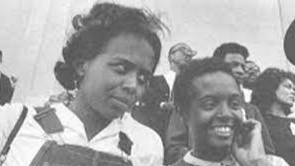L to r: Vergie Hamer, Robin Hamilton, Rev. Ed King, Dorie Ladner, Dr. Leslie McLemore. Photo courtesy of Robin Hamilton
The first time I met Dorie Ladner was at the March on Washington Film Festival in 2017 in the Metropolitan AME Church in Washington, D.C. She was part of a panel of movement stalwarts I’d produced commemorating their leader and comrade, the late Fannie Lou Hamer.
On either side of her onstage were Rev. Ed King and Dr. Leslie McLemore, original members of the Mississippi Freedom Democratic Party. They were all featured in a short film about Mrs. Hamer, This Little Light of Mine, by Robin Hamilton, screened that evening.
Rep. Eleanor Holmes Norton made opening remarks, recalling her first assignment upon arriving in Mississippi, fresh out of law school, was to get Mrs. Hamer out of jail.
Julian Bond was in the audience. I remember Robert (Raben, the festival founder) telling him he was top of our list of Civil Rights icons we’d highlight at the next year’s festival. A few weeks later, he was gone.
Joining the Mississippi NAACP and SNCC as a teenager, Dorie was a constant presence in marches, rallies, grassroots organizing and voter registration campaigns. She and her younger sister, Dr. Joyce Ladner, were the go-to D.C. speakers for many MOWFF events focused on that tumultuous period.
In 2019, the Festival held a provocative panel contemplating the fate of Carolyn Bryant, the wife of one of the murderers of Emmett Till. It was Bryant’s claim that Till assaulted her that led to the young boy’s death, a claim she later admitted was false.
Dr. Ladner was in the audience that night and spilled a little family tea.
“I got a woman in Jackson, I ain’t gonna say her name
She’s a brown-skin woman but I love her just the same.”
-Bob Dylan, Outlaw Blues
In the summer of 1963, Dorie and Joyce traveled to New York City to volunteer for the March on Washington organizing committee. They crashed on the couch of Rachelle Horowitz, a CORE organizer who lived in the same co-op building as Bayard Rustin where the first March planning meetings were held.
Horowitz’s apartment – a movement crash pad – served as rehearsal space for a young John Lewis to hone his speech. Bob Dylan was also there, ostensibly practicing his performance for the March. But in reality, he was there to serenade Dorie.
Joyce recalled returning to the apartment after a long day of organizing to find Dylan sitting on the couch, singing to Dorie. The private concert went on well into the night, while Joyce fervently wished he would just leave so they could pull out the couch and go to sleep. Horowitz eventually threw him out.
It is said that “the woman in Jackson” in Dylan’s song is Dorie Ladner. To be memorialized in the Dylan canon may indeed be an honor, although made less so in this instance by the “but” in the second line.
The legion of Americans who revere Dorie Ladner know she deserves much much more.
Scores of obituaries will chronicle all of the great work of this tireless freedom fighter. And rightfully so. Let us also remember the sister who stood by her side all their lives. We are all her siblings now.

Dorie & Joyce Ladner at the March on Washington, 1963
Dorie Ann Ladner, 1942 – 2024. Of gracious mien, brilliant reasoning, seasoned courage, and immovable commitment.
Isisara Bey






